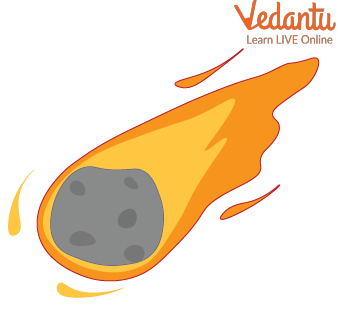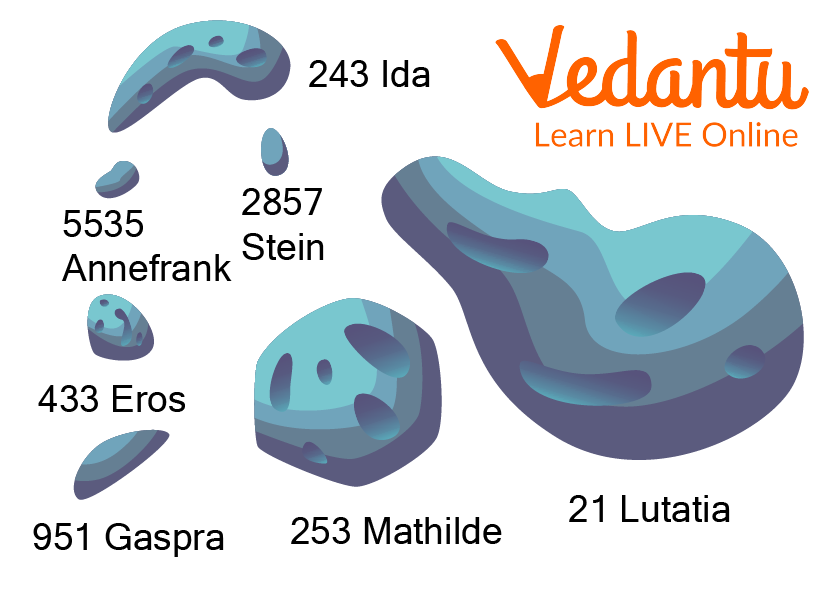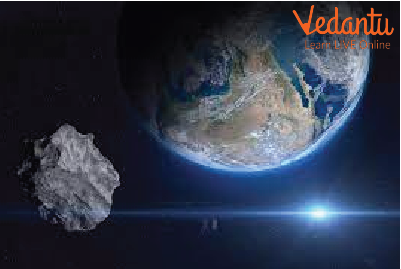




An Introduction to Asteroids
We are going to learn about a very interesting topic: asteroids. Asteroids, sometimes known as minor planets, are stony byproducts of the early solar system formation, which took place approximately 4.6 billion years ago. There are 1,113,527 known asteroids as of now. The main asteroid belt, which is located among Mars and Jupiter and orbits our Sun, contains the majority of this old space debris.
The asteroids also rotate, occasionally rather wildly, tumbling as they go through their elliptical orbits, around the Sun. Asteroids range in size from rocks under 1 metre across to nearly 1000 kilometres for the largest. Asteroids may have provided the early Earth with the materials required to start life. In this article, we will discuss the definition of an asteroid, the size and facts about asteroids and where asteroids come from.

Asteroids
Definition of Asteroid
Asteroids are tiny planets that fall outside of the category of a planet or a comet. These are typically found in the inner solar system, commonly known as the straight orbit around the Sun. Planetoids are another name for the larger varieties of asteroids. These are distinct from the outer solar system's minor planets in that they have surfaces made of volatile material, much like comets. These are commonly referred to as the asteroid belt.
Size of Asteroids
Asteroids can range in size from 1000 km to 10 metres. The three largest asteroids have distinct interiors despite having a nearly spherical form resembling a little planet. However, the majority of them are small and have atypical shapes. The asteroids are divided into three primary groups: C type, S type, and M type, according to their chemical components, which include their carbon content, metal composition, and silicate content.

Different Sizes of Asteroids
Facts of Asteroids
The following are some common asteroid facts:
Italian astronomer Giuseppe Piazzi made the initial asteroid discovery in 1801.
It is known as Ceres and has a diameter of roughly 950 kilometres. It is now considered a dwarf planet.
The designation of dwarf planet was granted to Ceres, Pluto, Eris, Makemake, and Haumea in 2006. Since the first asteroids were found, technology for finding them has advanced significantly, and astronomers now have access to a wide range of powerful telescopes to help with their studies and discoveries.
Where Do Asteroids Come from?
Our solar system's formation has left behind asteroids. When a large cloud of gas and dust imploded, our solar system came into being some 4.6 billion years ago. When this occurred, the majority of the material dropped to the cloud's core and created the Sun. In the cloud, a few of the condensing ducts developed into planets. The asteroids in the belt never got the chance to develop into planets. They are remains from the long-ago period when planets were forming.

Asteroid Image from NASA
Do Asteroids Differ in Any Way?
Yes! No two asteroids are alike since they formed in various places at various distances from the Sun. They are different in the following ways:
Unlike planets, asteroids are not circular. Their shapes are erratic and jagged.
Many asteroids are smaller than pebbles, yet some have diameters of hundreds of kilometres.
The majority of asteroids are composed of various types of rocks, although some also contain clays or metals like nickel and iron.
How Can Asteroids Teach Us Something?
Asteroids may teach scientists a lot about the formation of planets and the Sun because they developed at the same time as other solar system objects. Asteroids have also been flown by and studied by numerous NASA space missions. The OSIRIS-REx spacecraft was launched by NASA in 2016 to investigate the asteroid Bennu, which is close to the Earth. After several years of research on Bennu, OSIRIS-REx collected a sample of pebbles and dust from the asteroid's surface.
Summary
Small things in the Solar System are called asteroids that revolve around the Sun. They are made of metal and rock and may contain biological materials. Asteroids and comets are similar, but asteroids lack comets' observable coma (fuzzy outline and tail). Asteroids range in size from rocks under 1 metre across to nearly 1000 kilometres for the largest. The three largest resemble small planets in that they are nearly spherical, contain interiors that are at least partially differentiated, and are believed to be still-existing protoplanets.






FAQs on Asteroids
1. What kinds of asteroids are there?
Asteroids are divided into three major groups according to their chemical makeup, which includes their carbon content, metal composition, and silicate content. The majority of known asteroids are of the C-type, which also dominates the outer region of the asteroid belt. C-type asteroids make up 75% of the known asteroid population. S-type asteroids are moderately bright and primarily composed of iron and magnesium silicates. The innermost asteroid belt is where you'll mostly find these. M-type asteroids are those that contain iron and nickel in their purest form.
2. Can we survive on an asteroid?
Asteroids lack the magnetic field and atmosphere that shield us on the Earth from harm. Living inside an asteroid is one way to protect yourself from harmful radiation. It is anticipated that by tunnelling 100 metres deep under an asteroid, humans would be sufficiently shielded from radiation. Landing spacecraft on an asteroid is challenging since they do not produce much gravity. The asteroid belt, between Mars and Jupiter, is where the majority of asteroids are found. With temperatures ranging from -73 to -103 degrees Celsius, this is a frigid area.
3. What are asteroids made of?
Most Asteroids are chondrites, made from clay and silicate. Some are stony and include nickel and iron.









